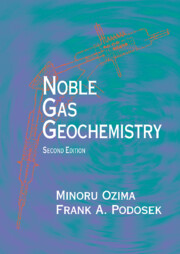Chapter 2 - Physical Chemistry
Published online by Cambridge University Press: 18 August 2009
Summary
Introduction
The noble gases are also well known as the inert gases, reflecting their characteristic lack of chemical interaction with other elements. In the extreme case, a substance whose atoms fail to interact with other substances except by elastic collisions would always be an ideal monatomic gas. In general, the noble gases approach this extreme more closely than other elements. Nevertheless, of course, the noble gases do not fail completely to undergo interactions, and such interactions as do occur are responsible for governing their geochemical distributions.
A number of the basic parameters characterizing the noble gases as elements are presented in Table 2.1. This chapter will treat those aspects of noble gas interactions with other substances that are important geochemically. A much broader and more extensive treatment of the fundamental physical and chemical characteristics of the noble gases can be found in Cook (1961).
It is now well known that despite their name the noble gases (at least Rn, Xe, and Kr) do, in fact, participate in interactions normally considered chemical, notably with F but also with other elements, and the Xe-F bond strength is a substantial 30kcal/mole. Noble gas chemistry is accordingly a subject of considerable theoretical interest. Nevertheless, it is extremely unlikely that conditions resulting in the formation of noble gas compounds would be encountered outside the laboratory, so noble gas chemistry will not be important in geochemistry and will not be discussed here.
- Type
- Chapter
- Information
- Noble Gas Geochemistry , pp. 30 - 80Publisher: Cambridge University PressPrint publication year: 2001



